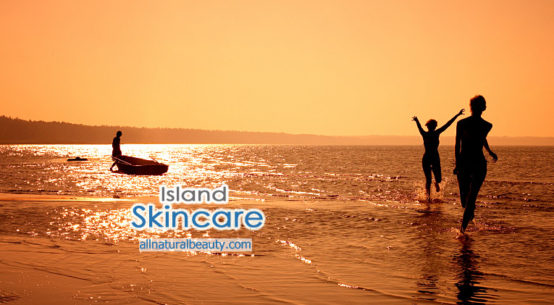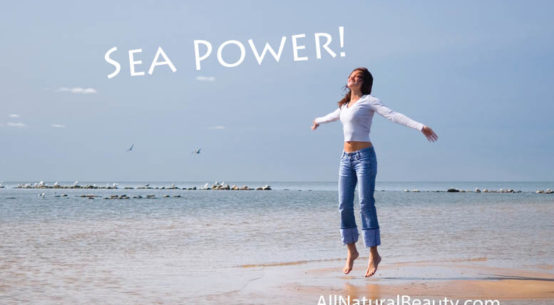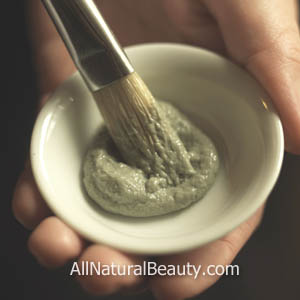
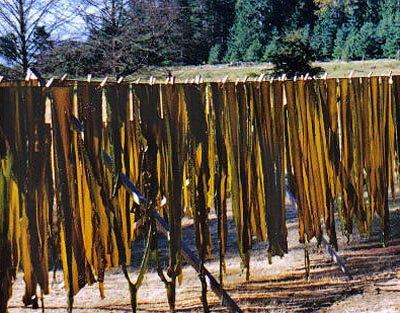
Growing up in rural Nova Scotia and spending my early years right by the Bay of Fundy, I love to work near the ocean, close to nature’s wild edibles “the seaweeds”. Being a Pisces, it was only natural to find myself on an island, harvesting the fruits of the sea.
However, how I got into the seaweed business was a surprise even to me. My trade was in stained glass as an artisan, first in Montreal and then in Nova Scotia. I love to travel and in 1991 I decided to take a year off to venture and explore the Queen Charlotte Island, located in Northern British Columbia Canada.
By a sheer coincident, there I was to come across an apprenticeship program given by Master Herbalist and widely known international lecturer, Ryan Drum PhD AHG.
Ryan Drum teaches first hand the art of wildcrafting medicinal herbs and seaweeds, on his acreage on the beautiful and remote Waldron Island in western Washington. Ryan teaches in a manner that respects the plants and the environment in their natural habitat. I was taught the proper harvesting methods of an array of wild plants, including (depending on the season) leaves, roots, berries, bark, flowers and seeds. The course also taught how to process and prepare tinctures, poultices, ointments, salves and oils for medicine.
In the 4 years that I spent with the plants, soaking it all up, I fell in love with the wild seaweeds.
In 1995 I earned my wildcrafting certificate, accredited by the Dominion Herbal College in Vancouver BC Canada.
I was now ready to set out on my own, and my vision was now to start a wild seaweed business, that would specialize in premium quality wild seaweeds, I was to call it BC Kelp.
Beautiful British Columbia, on Vancouver Island. What better place to look for the perfect location to realize my dream? After much scouting and luck, I found such a place on the picturesque and scarcely inhabited, Sidney Island, near Vancouver Island, BC.
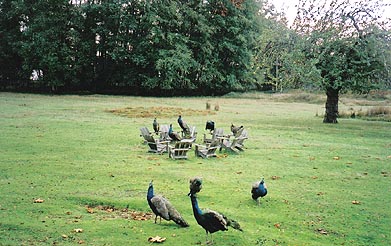

where conditions are ideal for beautiful and abundant seaweeds.
What are Seaweeds/ Seavegetables?
They are large visible sea plants scientifically called Macrophytic Algae. There are 3 types of seaweeds, classified by their pigments and respective vegetative and reproductive structures.
1) Brown Algae – There are various different seaweeds in the brown algae category (over 1,500 types), for example Bladderwrack (Fucus spp.) and Bullwhip Kelp (Nereocystis leutkeana) are seaweeds in the Brown algae family, yet they look quite different and are very similar in the nutrient content. They also share the same substance called Algin.
For the beauty market, this natural seaweed gel, Algin, is what is used to make cosmetics. It is used mainly for its water-holding, emulsifying and gelling properties. For example, alginates are used in making shampoos, cosmetics, conditioners, shower gels, face masks, etc… It is also used as a binding agent in many foods.
2) Red Algae – Red seaweeds can also look very different in appearance but basically have the same properties and substances. There are over 4,000 different species of red seaweeds. They all contain two different gel-like substances (phycocdolloids, natural seaweed gels) similar to Algin. These are called Agar and Carrageenan. They are found in different types of seaweed within the red group.
Commercially, Carrageenan and Agar are used much the same way as Algin, they are basically interchangable. In the beauty industry the seaweed gel in these two groups (Brown and Red) is very valuable in its uses and is much sought after. These gels are very nutrient rich and are great natural binding agents for the manufacturing of cosmetics, as well as foods in other applications. For example, Carrageenan is widely used in ice cream as a thickener. It is also used to add creaminess to yogurt, ice cream, chocolate, salad dressing, etc.. The green seaweeds do not contain these gels.
Agar is found in certain red seaweeds. The main uses for agar is in the food industry and in microbiology. When agar is added to a substance it gels it into a solid form, just like Jell-O. Agar is mainly used in microbiology because there are almost no bacteria that can digest it.
3) Green Algae – There are over 5,000 species. Green seaweeds do not contain these thickening or gelling properties as do the brown and red seaweeds therefore they are not used industrially for cosmetics or pharmaceutical. They are however widely used as a delicious additive to many dishes. I have eaten the very common north pacific green seaweed called Sea lettuce (Ulva). It grows at the mid to low tide mark. It is light green and very delicate in texture. Fresh does not taste very good, too rubbery. When dried the taste is enhanced to a delicious shrimp like flavor. Tasty when added to sea foods and chowders. It is difficult to find sold commercially because unlike some of the other seaweeds it has a very short shelf life.
Helpful hint: You can extract Algin from brown seaweeds or Carrageenan from red seaweeds by boiling the fresh or dried seaweed in water until it forms a thick liquid, then strain all through a sieve or cotton cloth to obtain the seaweed gel.

Grows on rocks at the mid to low tide mark.
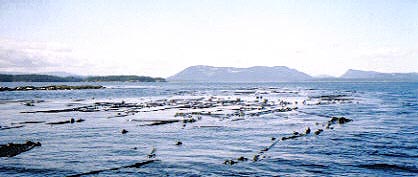
Some Kelp Facts
Since my company, BC Kelp, specializes in harvesting Kelp, I’d like to give you some interesting information about this wonderful sea vegetable.
Where does Kelp grow?
Kelp grows in fast moving cold water of the northeast pacific ocean
from northern California to southeast Alaska.
What does Kelp look like?
Kelp has long stipes which grow from attached hold fasts on rocky sea floors at depths of up to 100ft.Its many 6 to 12 inch wide, thick tender leaves grow out of a large hollow bulb at the top of each solitary stipe; these leaves or fronds can grow to 60 feet in length.
Harvesting
Only the leaves are harvested, leaving the plant to regrow. The fronds drain off their surface seawater as they dry in full sun hanging from stainless steel lines for 6 to 8 hours.
Reproduction
Kelp (Nereocystis leutkeana) spore patches are the darker squarish areas in the kelp frond. These spore patches are called sori. The sori eventually fall out and settle on the ocean bottom. The sori are then released and grow into microscopic male and female plants which reproduce sexually. The male plant releases sperm which attract to the egg of the female plant. The egg is then fertilized and the outcome is a brand new kelp plant.

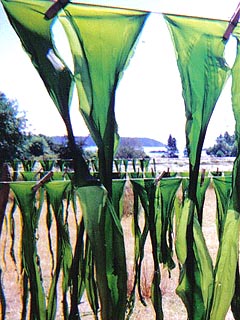
Nutritional value of Seavegetables/Seaweeds.
Seaweeds are an excellent source of minerals, especially potassium, sodium, calcium, magnesium, nitrogen, iron, zinc, boron, copper, vanadium and nickel. Often better sources than meat, whole milk or eggs.
No land plant has even 1/2 the essential mineral content of seaweeds. Seaweed is one of the richest plant sources of Iodine, which was discovered in 1811 by Bernard Courtois, a French scientist. The discovery was made by mistake, as Bernard was looking for Sodium Carbonate from seaweed ashes. The reason for this was to create the much needed gun powder for Napoleons’ army. Iodine is essential to animals and humans, it’s found in thyroid hormones.
Kelp is also high in vitamin A, B-complex (especially B-6 and B-12) also vitamins D, E and K.
Interesting fact: Any salt or salty taste on this kelp comes from within the kelp and is predominantly potassium, rather than sodium.
Seaweed and Beauty
Seaweeds have a long history in European culture as a health or beauty product. Seaweeds and/or seaweed extracts are used in thalassotherapy (seawater skin care therapy).
Today seaweeds are used in many beauty products from skin cream to shampoos. Also common in spas in seaweed/mud baths and body wraps. The abundant minerals are readily absorbed by the skin. Seaweed baths are detoxifying, relaxing and rejuvenating.
Seaweed Beauty Recipes
Easy Seaweed Mineral Bath
Ingredients:
Bladderwrack (Fucus spp.)
Directions:
Place about 35g or 3tbls. flaked Bladderwrack in cotton scarf, tie tightly closed with string or elastic (loose flakes may clog drain). Throw in hot bath water. When you soak in a warm seaweed Bladderwrack bath, your skin absorbs the abundant vitamins and minerals from the seaweed, which nourish and sooth the skin. Also breath in the fresh ocean breeze !
Clay/Seaweed Facial Mask
Ingredients:
4 T Facial dry Clay
tsp. Kelp powder (Nereocystis leutkeana)
Directions:
Add small amount of warm water, (enough to make a not too runny paste).
Apply thinly to face, let dry. Rinse off. (Approx. time 15 min.)
Seaweed Powder Face Wash
Kelp’s minerals are wonderful for the skin. This is a quick, facial mineral cleanse, which leaves your skin silky soft!
Ingredients:
A pinch or two of Kelp powder
Add a few drops of water (enough that it is runny, not lumpy)
Directions:
Sprinkle a pinch or two of Kelp powder in palm of hand, over the sink. Rub vigorously on face for 15 seconds or so. Rinse well.
Easy and Tasty Seaweed Recipes
Scrumptious, crispy, green kelp fronds can be eaten right out of the bag or sprinkled in soups, green salads, seafood, omelets etc… Use kelp as a healthy salty condiment as you would salt .
Seaweed Salad
Wash and cut up salad greens, onions or garlic (enough for four bowls of salad)
(My favorite salad greens are, Kale, Dandelion leaves, Chickweed and Arugula).
Dressing:
4 to 5 tbl Olive oil
2to 3 tbl Vinegar
3to 4 tbl Soya sauce
1/4 to 1 cup Kelp flakes
Mix dressing with salad. Add Kelp flakes. Toss and serve!
Yummy Kelp Powder Popcorn
On hot popcorn sprinkle equal amounts of :
edible Yeast (also called nutritional yeast)
Kelp powder.
Drizzle with olive oil. Enjoy!
Rice and Kelp Salad
Steam 2 cups brown rice, when rice is cooked add:
5 to 6 T Olive Oil
2 to 3T Vinegar,
1-2 T Soya Sauce
4 to 5 cloves crushed or chopped Garlic or (a small chopped Onion)
1/4 to 1 cup Kelp flakes
Add all ingredients to rice, mix and serve warm or cold.
(Note: You can use dressing mix on pasta instead of rice. Delicious!)
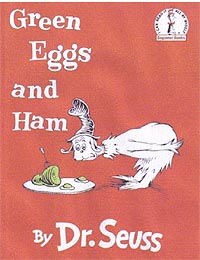
One may call to mind a children’s book of the same name by Dr. Seuss, when first faced with such a meal situation involving generous use of kelp powder from what had once been the salt shaker.
Suggested Reading:
Pacific Seaweeds: A guide to common seaweeds of the Pacific Northwest by Louis D. Druehl
Seavegetables by E.McConnaughey
Sea Vegetable Cookbook & Forager*s Guide by E&J Lewallen
Medocino Sea Vegetable Co.
Cooking with Seavegetables by Sharon Rhoads
The Seavegetable Book by Judith C, Madlener
The Healing Power of Minerals by Paul Bergner
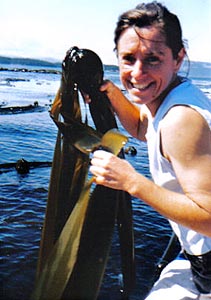
BC Kelp specializes in Bullwhip Kelp: (Nereocystis luetkeana) and Bladderwrack: (Fucus gardneri). After reading this article, you now know that these are two important sea vegetables for beauty care. You’ll also find all-natural Kelp Soap and Bath Pouches containing Kelp at this wonderful and informative web site.
Visit BC Kelp.com Now



